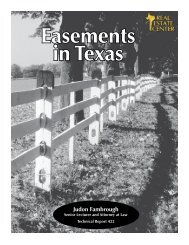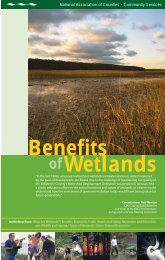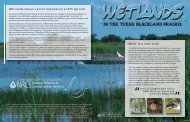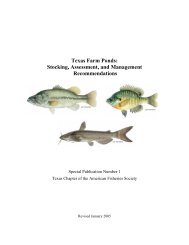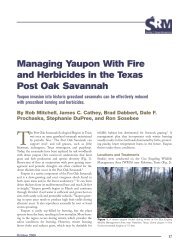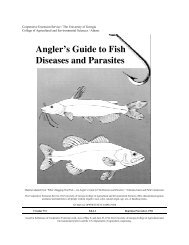Conservation Easements, A Guide for Texas Landowners
Conservation Easements, A Guide for Texas Landowners
Conservation Easements, A Guide for Texas Landowners
Create successful ePaper yourself
Turn your PDF publications into a flip-book with our unique Google optimized e-Paper software.
Part One: Wh at is a Co n s e rvat i o n Ea s e m e n t<br />
A conservation easement is a written agreement between a landowner and<br />
the “holder” of the conservation easement under which a landowner voluntarily restricts<br />
certain uses of the property to protect its natural, productive or cultural features. The holder<br />
of the conservation easement must be a governmental entity or a qualified conservation<br />
organization. With a conservation easement, the landowner retains legal title to the property<br />
and determines the types of land uses to continue and those to restrict. As part of the<br />
arrangement, the landowner grants the holder of the conservation easement the right to<br />
periodically assess the condition of the property to ensure that it is maintained according to the<br />
terms of the legal agreement.<br />
Many rights come with owning property, including the rights to manage resources, change<br />
use, subdivide or develop. With a conservation easement, a landowner limits one or more<br />
of these rights. For example, a landowner donating a conservation easement could choose<br />
to limit the right to develop a property, but keep the rights to build a house, raise cattle and<br />
grow crops. The landowner may continue his or her current use of the property, provided<br />
the resources the conservation easement is intended to protect are sustained.<br />
<strong>Texas</strong>’ landscape and its people are diverse. Because every landowner and every<br />
property is unique, a conservation easement agreement can be designed to meet specific,<br />
individual needs.<br />
Why Use a <strong>Conservation</strong> Easement<br />
<strong>Landowners</strong> interested in conservation generally have two principal concerns. First is the<br />
desire to protect the natural or productive qualities of their property. The landowner is<br />
interested in conserving special features such as fertile soil, mature trees, wildlife habitat<br />
or a piece of history – even after his or her ownership comes to an end.<br />
Along with conservation, landowners are also concerned about maintaining their<br />
property’s productivity. The economics associated with land ownership are changing and<br />
fewer family-owned properties are the primary source of a family’s income. Along with<br />
maintaining productivity, <strong>Texas</strong> landowners must also contend with the increasing tax<br />
burden associated with property ownership. Estate taxes, property taxes and the financial<br />
incentive to sell or develop are all economic factors that affect land use decisions.<br />
<strong>Conservation</strong> easements enable landowners to protect resources they value <strong>for</strong> their<br />
children and future generations while maintaining private ownership. In <strong>Texas</strong>,<br />
conservation easements are generally donated to nonprofit conservation organizations,<br />
commonly known as land trusts. The donation of a conservation easement can have<br />
potentially significant tax benefits, which are discussed later in this guidebook.<br />
<strong>Conservation</strong> easements are recognized <strong>for</strong> legal and tax purposes by the State of <strong>Texas</strong><br />
(Chapter 183, <strong>Texas</strong> Natural Resources Code) and the Internal Revenue Service (Internal<br />
Revenue Code, Section 170(h)). This guidebook will answer general questions that a<br />
landowner might have about conservation easements. Be<strong>for</strong>e completing a conservation<br />
easement agreement, landowners should consult with their legal and tax advisors.<br />
4 <strong>Conservation</strong> <strong>Easements</strong>:



